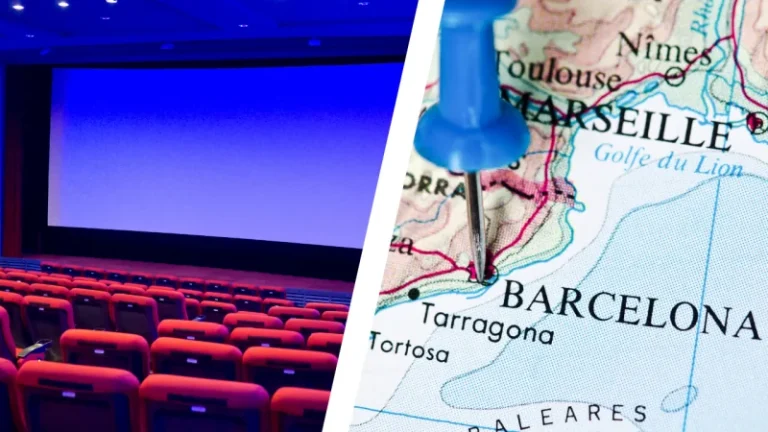What is Siesta (And How to Sleep One)?
Siesta is an afternoon nap in Spain. But understanding what siesta is will require us to look deeper.
In June 2023, Spain published the General Law for the Protection of Consumers and Users and established specific regulations for the timing of commercial phone calls.
While it’s not officially called so, it is exactly this – Spain’s siesta law.
According to the law, commercial calls are allowed Monday through Friday from 9:00 AM to 9:00 PM (excluding bank holidays).
The biggest telco companies, Orange, Telefónica, MásMóvil, and Vodafone, signed an additional code of ethics that prohibits them from calling people during siesta time.
You read that right. Commercial calls are prohibited between 3:00 PM and 4:00 PM – siesta time!
Now, we’ll explore why this is such a game changer.
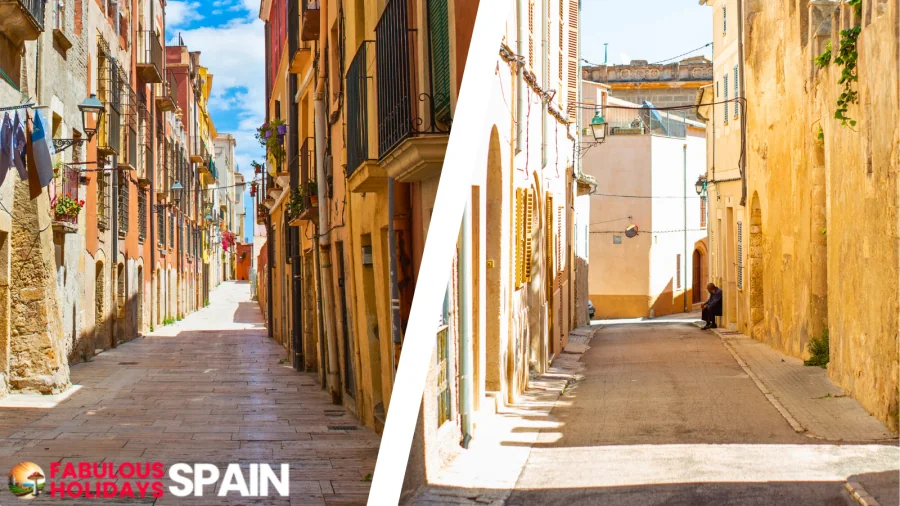
This complete guide to siesta has 17 parts. I made it easy for you to jump straight into the most interesting part.
My Siesta Experience
New legal regulation and siesta Code of Ethics
Origins of the Siesta
Siesta Around the World
Factors Contributing to the Declining Siesta Tradition
Impact of the Declining Siesta
Presenteeism in Spain
Criticisms of the Siesta
What are Siesta Benefits
Siesta and its new-age Version: Meditation
How to Get Some Siesta Yourself
Workplace Siestas
4 Common Siesta Myths
10 Surprising Siesta Facts
Cultural Adaptation of Siesta
Future of the Siesta in Spain
So, siesta yes or no?
My Siesta Experience
In Spain, telco, energy, and some other companies use call centres with automated dialers to call and sell new ‘offers’ from early morning to 10 PM. Sometimes, even later, if they couldn’t snipe you earlier in the day.

And it’s not your telco company that calls you; this would perhaps make sense. It’s other companies trying to take over competitors’ businesses.
What’s mind-boggling is that they use computer-generated numbers to call. The computer creates and calls numbers sequentially: 111, 112, 113, and so forth.
How do I know? I never published my mobile number anywhere.
Now, picture this.
At siesta time, people in Spain sit down for lunch, around 2 p.m. Then the phone rings.
You pick up and wait for a call centre software to connect you to the first available operator.
After waiting awkwardly for 10 seconds (and trying to swallow the bite), the call centre person starts talking like rain.
Still, with a meal in your mouth, you try to get rid of the person and return to lunch.
The caller is persistent (trained this way) and talks until you drop the call.
It is unpleasant, to say the least. It wastes a calling company’s resources and disturbs the consumer.
It does no good, so it’s better for everyone not to make sales calls during siesta time. At least not in Spain.
New Legal Regulation and Siesta Code of Ethics
The new 2023 regulation reflects the understanding that the siesta is an integral part of Spanish culture, providing an opportunity to eat, recharge, and re-energize for the remainder of the day.
Because working days here in Spain are long!
By respecting the siesta period, Spanish siesta law ensures that consumers can enjoy this relaxation time without being disturbed by sales calls. It strikes a balance between commercial interests and individual well-being.
Siesta is a time to disconnect from work and prepare for the busy afternoon ahead.
It’s not necessarily productive, but we will get to that in a moment.
Origins of the Siesta
The siesta is a well-known tradition in Spain but also in other countries. While its popularity has declined recently, it remains an integral part of Spanish culture.
The origins of the siesta can be traced back to ancient times. The word “siesta” is derived from the Latin word “hora sexta,” meaning “sixth hour,” referring to the practice of taking a break in the middle of the day during the hottest part of the Roman Empire.
The siesta was initially adopted for practical reasons. The Mediterranean sun made working during the hottest hours of the day unbearable.
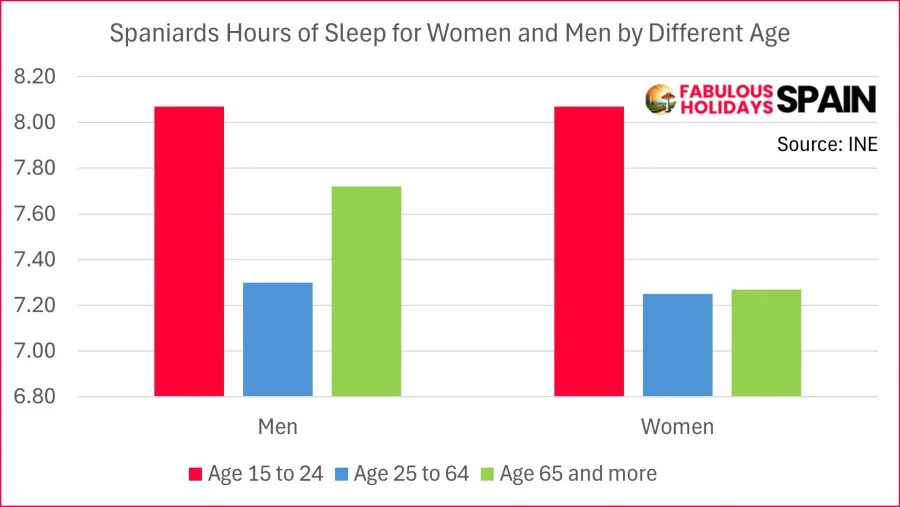
In 2013 a Spanish national commission revealed that Spaniards sleep 53 minutes less than the Europeans.
Taking a break allowed people to rest, recharge, and return to their work with renewed energy.
In the past, the siesta was often tied to agricultural work. Farmers would take a break from the fields in the midday to escape the heat and enjoy a leisurely meal with their families.
Such short rest made people more alert and productive during the cooler hours of the day.
Siesta Around the World
From the sunburned Mediterranean to the busy streets of Asia, the tradition of taking a siesta has long been a cultural thing in many countries.
While its prevalence varies across regions and generations, the concept of taking a nap in the afternoon to recharge and re-energize remains deeply rooted in some cultures.
Let’s explore what a siesta is and what it looks like around the world.
What is siesta like in Spain?
Spain is often seen as the quintessential siesta country, with its origins dating back to the Roman era.
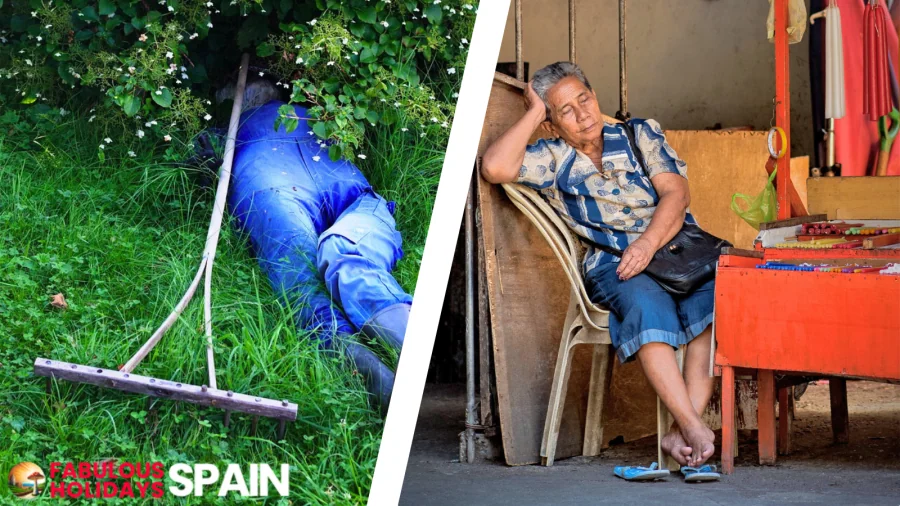
The midday heat and midday meals traditionally prompted Spaniards to take a break to escape the stifling temperatures and digest their meals more effectively. This tradition continued through the centuries, becoming deeply embedded in Spanish culture.
Today, urbanization, changing work schedules, and a globalized economy have led to a decline in the popularity of siestas in Spain. Still, the practice holds significance in certain regions, especially among older generations and rural areas.
What is siesta like in Italy?
In Italy, the siesta is more prevalent in southern regions like Naples and Sicily, where the tradition is often accompanied by a leisurely meal of pasta and fresh fruit. In northern Italy, where the climate is milder and work schedules more demanding, siestas are generally less common.
What is siesta like in Latin America?
Latin American countries, such as Mexico, Peru, and Colombia, also have a rich history of siestas. In these regions, the siesta is seen as a way to adapt to the natural rhythm of the day, taking a break in the sweltering afternoons to conserve energy for the evening hours.
What is siesta like in Asia?
In Asia, rest is often integrated into daily routines, but siestas are not as widespread as in other parts of the world. In countries like Japan, South Korea, and China, workers typically take short breaks throughout the day to step away from their desks and recharge.
The Prevalence of Siestas Today
While the siesta’s decline is evident, there is a growing movement to revive the practice, emphasizing its potential health benefits and its role in promoting work-life balance.
Factors Contributing to the Declining Siesta Tradition
Spain’s transition from an agrarian economy to a service-oriented one has led to a shift in working hours. Businesses now operate longer, extending into the afternoon, making the siesta impractical for many workers.

As Spain integrated into the global economy, it faced increasing competition from other countries with shorter workdays.
Businesses adopted more flexible working arrangements to accommodate global markets, further reducing the prevalence of the siesta.
The rise of cities has transformed how people live and work. Urban environments demand a more structured and continuous workday, making it difficult for individuals to incorporate a midday nap into their schedules.
Impact of the Declining Siesta
The decline of the siesta has been linked to increased stress, fatigue, and health problems among working Spaniards.
The waning popularity of the siesta has raised concerns about the erosion of Spain’s unique cultural identity.
The siesta was deeply embedded in Spanish culture and tradition, and its decline is seen by some as a loss of a defining aspect of Spanish identity.
The absence of the siesta has led to a culture of presenteeism, where workers feel compelled to stay at their desks for extended periods, even when they are tired or unproductive.
Presenteeism in Spain: A Costly Culture
It’s fascinating how change in one area of life can influence others. Eliminating the siesta’s impact is shown in the appearance of presentism.
Presenteeism refers to going to work even when you are not feeling well or cannot perform your duties at the expected level. Presenteeism is a widespread problem, costing businesses billions of dollars each year in lost productivity and healthcare expenses.
“Presenteeism is being present at work more than needed to seem more serious and committed to your organization,”
– Marc Grau from Harvard Kennedy School
“It is prevalent in Spain due to the traditional mentality of ‘more hours equals more work’ he adds.
The Connection Between Presenteeism and Siesta
Presenteeism and siesta are two concepts that seem to be at odds with each other.
Physically present employees at work are not mentally or emotionally engaged. This likely leads to reduced productivity, increased errors, burnout, and even disease.
The deeply ingrained presenteeism culture and “old mentalities” in the Spanish workplace pose a significant challenge for ambitious companies seeking to adapt to cultural practices like siestas.
The work culture in Spain emphasizes physical presence over well-being and productivity. This can lead to presenteeism, burnout, stress, and other negative impacts on employee health and productivity.
This outdated mentality advocates the belief that “the more hours you work, the more productive you are” and promotes presenteeism.
Some estimates suggest that up to 72% of productivity losses may be due to presenteeism, compared to 28% due to days off due to illness.
What are Siesta Criticisms?
Some people believe that the siesta is a major factor in Spain’s high rates of presenteeism. They argue that the siesta can make employees feel tired and unproductive in the afternoon, as they are not fully rested when they return to work.
What is Siesta’s Main Benefit?
Have you ever felt that midday slump where your eyelids start to droop and your brain feels like mush?
Well, you’re not alone. Many people experience afternoon fatigue, which can seriously affect productivity and mood.
I prepared a handy table for you to glance at daily performance.
| Hour | Human Activity * |
| 3:00 AM – 6:00 AM | Waking up, feeling refreshed, increased alertness |
| 6:00 AM – 9:00 AM | Peak for information processing, logical thinking, problem-solving |
| 9:00 AM – 12:00 PM | Highest productivity, creativity, and motivation |
| 12:00 PM – 2:00 PM | Post-lunch slump, lower energy levels, reduced focus |
| 2:00 PM – 5:00 PM | Revived energy, increasing ability for learning and memory |
| 5:00 PM – 8:00 PM | Evening energy boost |
| 8:00 PM – 11:00 PM | Peak creativity, emotional sensitivity |
| 11:00 PM – 2:00 AM | Melatonin production increases, leading to drowsiness |
You can see that there is a meaning behind a simple solution that’s been practised for centuries: the siesta.
What is Siesta’s Impact on Alertness and Focus?
One of the biggest benefits of a siesta is that it can help you feel more alert and focused throughout the rest of the day – especially in the afternoon.
A study published in the US National Library of Medicine found that a 20-minute nap improved performance levels, perceived sleepiness, and self-confidence in their task performance.
“Napping is a powerful, very inexpensive way of improving our work,” says Steven Howard, MD, associate professor of anaesthesia and an author of a Stanford study showing the benefits of naps for healthcare workers published in the November 2006 Annals of Emergency Medicine.
A siesta or a nap can also help to reduce stress and improve mood. South African College of Applied Psychology published that taking a nap can lower levels of the stress hormone cortisol and increase levels of the mood-boosting hormone serotonin.
The same source claims that a nap after learning a new task can improve memory consolidation.
Some studies suggest that siesta can also boost creativity. A doctoral thesis by Houda Daaloul found that the benefits of a midday nap are most pronounced when it is taken between 1 and 3 p.m.
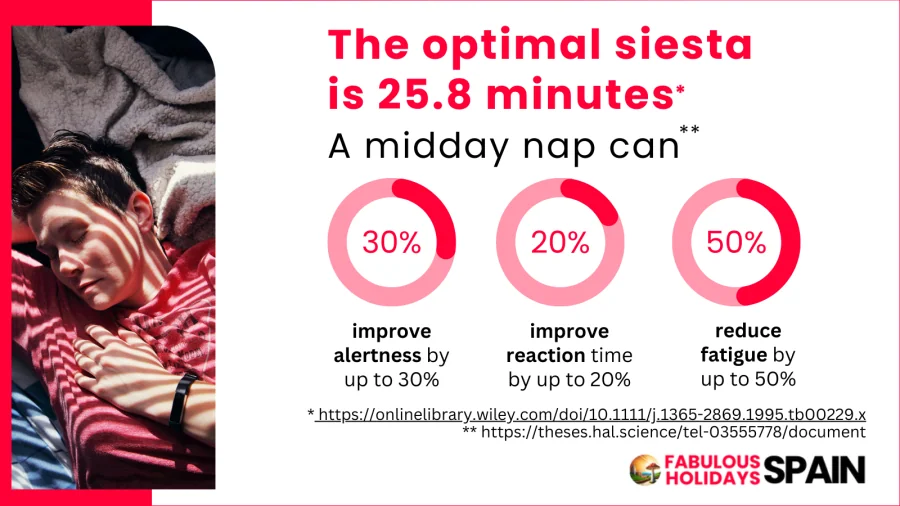
The doctoral work also found the optimal nap is 10-20 minutes.
What’s more, the author finds that:
- A midday nap can improve alertness by up to 30%.
- A midday nap can improve reaction time by up to 20%.
- A midday nap can reduce fatigue by up to 50%.
These numbers are so prominent that siesta could not be carelessly discarded.
Nuria Chinchilla, a professor at Spain’s IESE business school, said: “People have talked for a long time about the benefits of napping, and neuroscience is increasingly backing up the need for rest,” she said, but she added that siestas were largely a thing of the past.
In addition to these cognitive benefits, siesta may also have other health benefits, such as reducing the risk of heart disease, improving insulin sensitivity, and boosting the immune system.
While this sounds good, the modern lifestyle works against the siesta. More tasks, more commuting, longer hours.
There is also more stress but less opportunity for a siesta. We need another solution because the siesta won’t work.
Siesta and its new-age version: Meditation
What does meditation have to do with the siesta, you may ask?
Since my early years, I have cultivated an interest in practical science. To share my research with people from all walks of life, I have been publishing science articles for major newspapers for well over a decade.

One of the topics for my research was sleep, rest, and human mental performance. Physical performance is a consequence of a mental one, so I won’t discuss it in this article.
So, I have been looking for practical ways to increase performance, mood, and overall quality of life.
Over the years, I have practised siestas but also meditation.
Both siesta and meditation can improve overall well-being. If you are considering trying either of these practices, test both and find what works best for you.
To address the elephant in the room, meditation doesn’t require you to be a yogi sleeping on a bed of nails. It is a tool that (like siesta) improves brain and body performance.
Meditation is an easy yet powerful tool that can be practised in almost any environment and time.
On the other hand, Siesta is difficult to sleep because of the fast life tempo.
So, let’s take a look at how similar and different both tools are.
It’s useful to understand that human performance depends on brain waves.
Brain waves are electrical signals that are produced by the brain. They are measured in Hertz (Hz), cycles per second. There are four main types of brain waves:
- Beta waves: These are fast waves that are associated with alertness, focus, and problem-solving.
- Alpha waves: These are slower waves that are associated with relaxation and creativity.
- Theta waves are even slower waves associated with deep relaxation, daydreaming, and REM sleep.
- Delta waves: These are the slowest waves and are associated with deep sleep.
Brain waves typically shift from beta waves to theta waves during a siesta.
When the siesta is too long, brain activity may return to beta waves, making you feel drowsy. This is the scientific reason for keeping the siesta under 30 minutes.
During meditation, brain activity typically shifts from beta waves to alpha waves, and in some cases, it may also shift to theta waves. This is a sign of deep relaxation and mental stillness.
Similarities Between Siesta and Meditation
- Both siesta and meditation have the potential to improve cognitive function, reduce stress, and promote relaxation.
- Both can be practised in a variety of settings.
- Both can be beneficial to people of all ages and activity levels.
Differences Between Siesta and Meditation
- Siesta is a more passive activity, while meditation is an active one.
- Siesta is typically taken in the afternoon, while meditation can be practised at any time of day.
- Siesta is often associated with a specific culture or region, while meditation is a more universal practice.
| Feature | Siesta | Meditation |
| Purpose | To reduce fatigue and improve alertness | To reduce stress and anxiety, improve focus and concentration, and promote self-awareness |
| Duration | Typically 15-30 minutes | Typically 10-45 minutes |
| Time of Day | Typically taken in the mid-afternoon | Typically taken at any time of day |
| Environment | Dark, quiet room | Any environment |
| Position | Lying down or reclining | Sitting or lying down |
| Awareness | Minimal awareness of surroundings | Focus on the present moment or breath |
| Thoughts | May drift during the nap | Thoughts are observed without judgment |
| Physical sensations | May be noticed and accepted | Physical sensations are observed without judgment |
| Emotional state | May be relaxed or slightly agitated | Emotional state is observed without judgment |
Meditation is a viable tool for modern Spanish society, where the traditional siesta is declining. As a new tool, meditation can help increase people’s well-being, performance, and economic growth.
Now that we know what siesta is, let’s look at how you can try siesta yourself.
How to Get Some Siesta Yourself: Determine the Ideal Duration and Timing of Siesta
If you are up to sleep siesta and see the benefits yourself, here are the best practices.
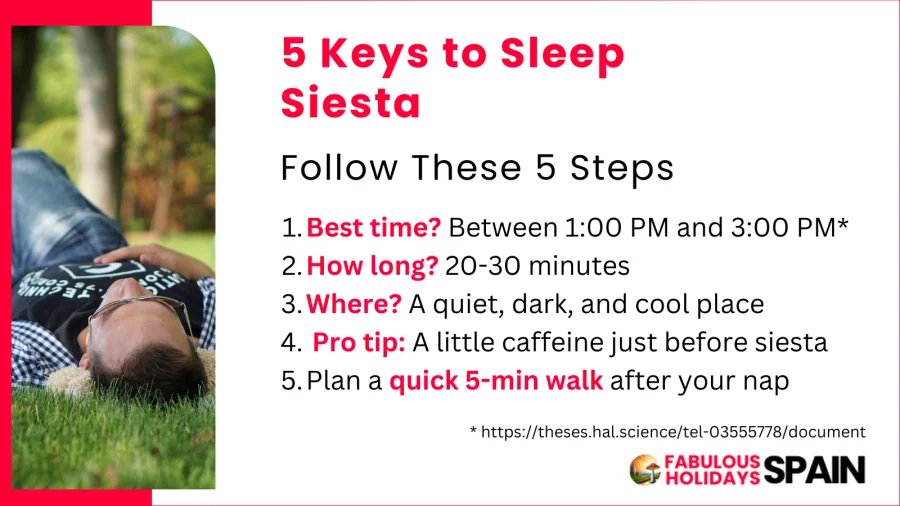
- Time your nap. The best time to take a siesta is typically between 1:00 PM and 3:00 PM, when your body’s natural sleepiness cycle is at its peak.
- Limit your nap length to 20 or 30 minutes. This seems to be ideal for most adults. If you nap for over 30 minutes, you may very well feel groggy when you wake up.
I like it under 20 minutes. It feels like 2-3 short brain (consciousness) disconnects. The relieving effects can easily last 1-3 hours, enough to overcome the afternoon energy downturn.
So here are some tips for your siesta experiment:
- Create a relaxing environment. Find a quiet, dark, and cool place to take your nap. You may also want to use a sleep mask, headphones, or earplugs to block out distractions.
- Take a small amount of caffeine and avoid excessive food before your nap. A little caffeine will help you wake up easier and more fresh. Also, avoid eating a heavy meal before your nap, as this can make you feel uncomfortable.
- Get some physical activity after your nap. A short walk will pump the blood in your body and help to increase awakeness.
What is Siesta at Workplace?
Workplace naps, also known as siestas, have been a part of Spanish culture for centuries. But they are now gaining popularity in other countries.
Sleep loss can dangerously damage your health, and successful companies know it. These companies also know that rested employees are high-performing employees.
One company that is embracing the power of the siesta is Google. The company has installed nap pods and full rooms in some of its offices worldwide. The pods are soundproof, dark, and temperature-controlled, making them perfect for a quick nap.
Google isn’t the only company that is offering its employees nap pods. Other companies embracing the siesta (nap) trend include Airbnb, Nike, Facebook, and Amazon.
4 Common Siesta Myths: Let’s Debunk Misconceptions About Siestas
Myth 1: Siestas are only for lazy people
Reality: Siestas can improve focus, concentration, and memory. A NASA study found ideal nap length for pilots was 25.8 minutes to maximize its effects on the job. This nap minimizes the effects of sleep inertia, the dazed sluggish feeling commonly experienced from longer naps.
Myth 2: Siestas are only for hot climates
Reality: Siestas can be beneficial regardless of the climate. A study by the National Sleep Foundation suggests taking a siesta in a cold environment.
Myth 3: Siestas are only for children
Reality: Siestas can be beneficial for people of all ages. A study by the Mayo Clinic found that napping can improve cognitive function and memory in adults.
Myth 4: Siestas are just a waste of time
Reality: Siestas can be a very effective way to improve your energy levels and focus. A Stanford University School of Medicine study found that the nap group scored fewer performance lapses, reported more vigor, less fatigue and sleepiness, and showed improved mood.
Napping doctors and nurses also tended to complete the simulated intravenous insertion more quickly.
You want your doctor to be focused and insert the injection fast and accurately, right?
10 Surprising Siesta Facts
Scientific research undoubtedly shows the benefits of siesta. Here are the ten most interesting ones.
- Fact 1: A short siesta (10-30 minutes) can improve alertness, cognitive function, and mood in older adults.
- Fact 2: Longer siestas (60-90 minutes) can lead to sleep inertia, grogginess, and confusion after waking up.
- Fact 3: Siesta can interfere with nighttime sleep, especially if too late in the day.
- Fact 4: Siesta may be helpful for older adults who have difficulty falling or staying asleep at night.
- Fact 5: Napping may be associated with a lower risk of dementia and Alzheimer’s disease.
- Fact 6: Siesta may be beneficial for older adults with chronic conditions such as heart disease, diabetes, and depression.
- Fact 7: Siesta is a culturally accepted practice in many countries worldwide.
- Fact 8: There is no one-size-fits-all approach to siesta for adults. The best way to determine if siesta is right for you is to talk to your doctor.
- Fact 9: If you do decide to sleep siesta, it is important to choose a quiet, dark, and comfortable place.
- Fact 10: Set an alarm to wake up after 30 minutes to avoid sleep inertia.
Cultural Adaptation of Siesta
In the fast-paced world of work, taking a break in the afternoon, known as the siesta, has often been seen as a sign of laziness. But this stereotype is far from the truth.
While the traditional siesta, a two-hour nap after lunch, may not be practical for most modern workplaces, adopting the concept to fit today’s schedules and cultures could have significant benefits for employee well-being and productivity.
What is a siesta adaptation to Modern Schedules?
Traditional siestas might not be the most practical option in today’s world. However, incorporating shorter power naps or even just a few minutes of quiet relaxation into the workday can significantly enhance productivity.
The key to adapting the siesta tradition lies in personalization. Recognizing that everyone has different preferences, companies can offer various options to suit individual needs.
Some employees might prefer a quiet room with dim lighting, while others could prefer to listen to calming music or briefly walk around the office.
What is a Siesta Future in Spain: A Revival in Sight?
The siesta, a tradition deeply rooted in Spanish culture, involves taking a nap in the afternoon, typically after lunch.
While once widely practised, the siesta has declined in recent decades due to factors such as globalization, changing work patterns, and the rise of modern technology.
There are signs that the siesta may return, but mostly because of its health benefits.
The decline of the siesta can be attributed to several factors. The rise of globalization and Spain’s integration into the European Union led to a shift toward a more structured work culture, similar to that of other European countries.
Additionally, the introduction of new technologies, such as laptops and smartphones, has enabled people to work from anywhere, further reducing the need for a break in the middle of the day.
Resurging Interest
Despite the decline, there are signs that the siesta may be returning. The idea of taking a nap to improve productivity and well-being is gaining traction, particularly among millennials.
Companies in Spain and other countries are beginning to embrace the concept of siestas, albeit in a more modern form.
The revival of the siesta could significantly impact Spanish culture and society. It could lead to a more balanced lifestyle and a healthier workforce.
So, siesta yes or no?
While the future of the siesta remains uncertain, there are strong indications that it is poised for a resurgence.
The growing recognition of the benefits of siesta and napping and the increasing adoption of flexible work arrangements could lead to a wider embrace of the siesta tradition, both in Spain and beyond.

